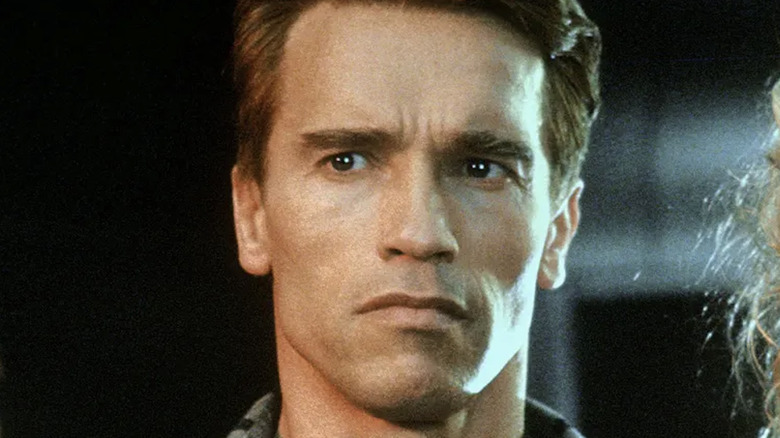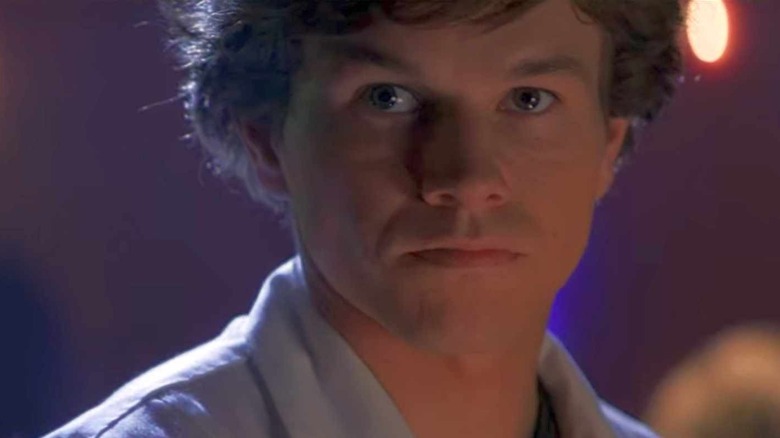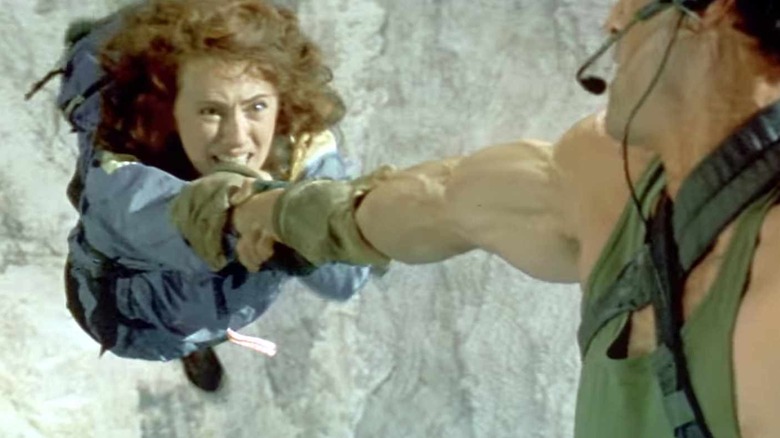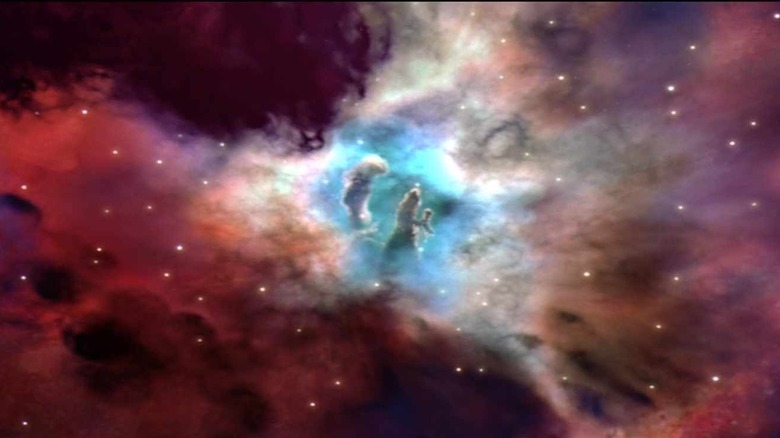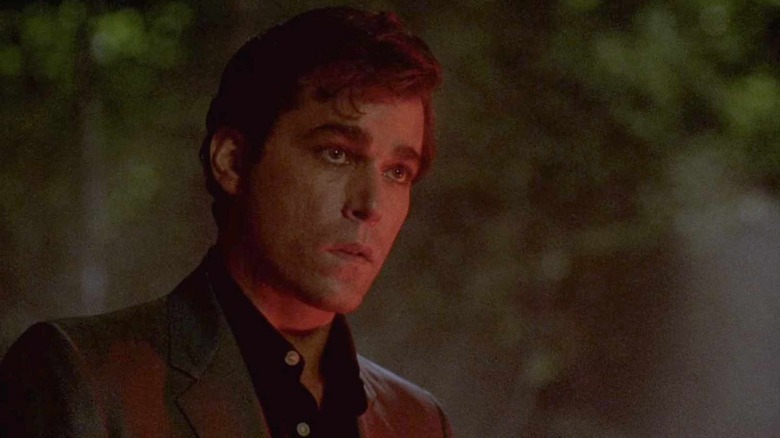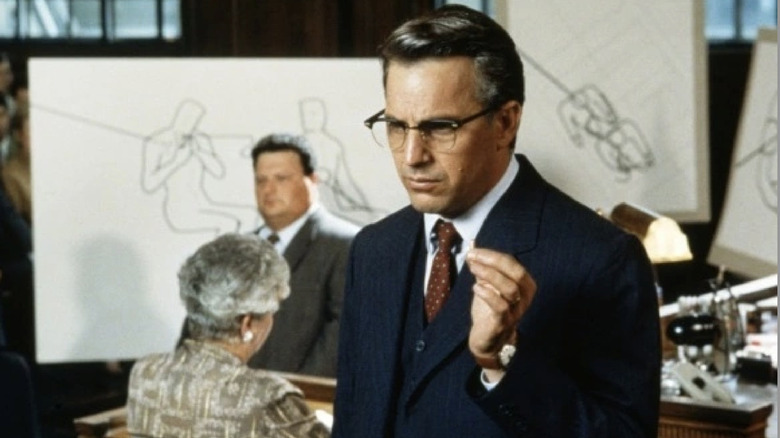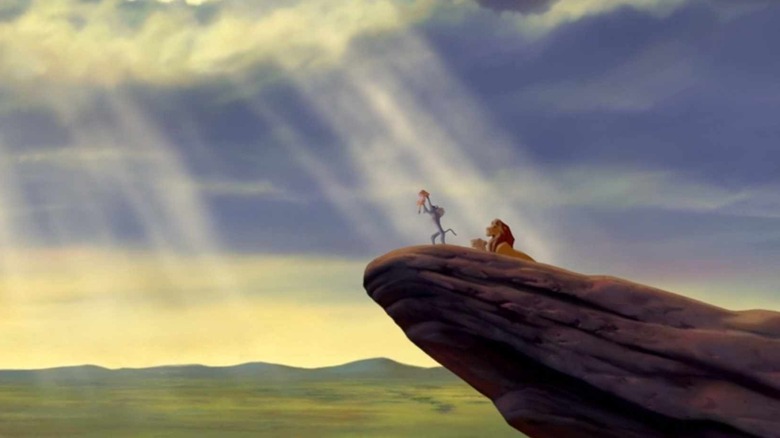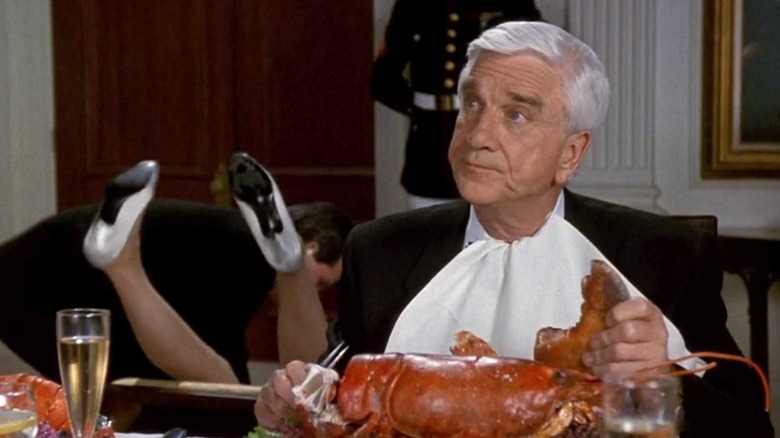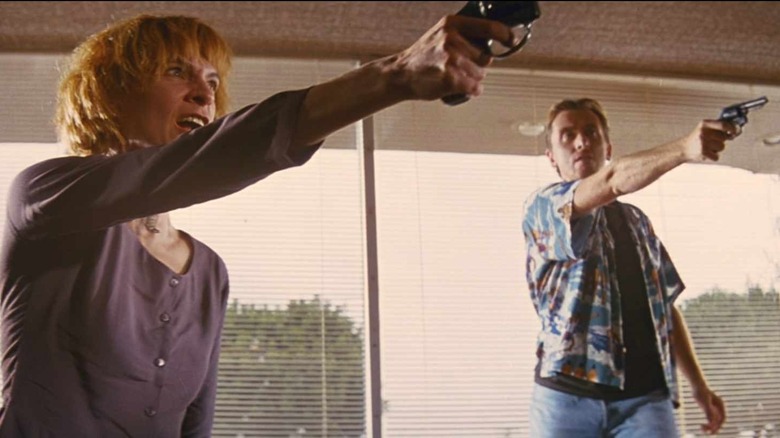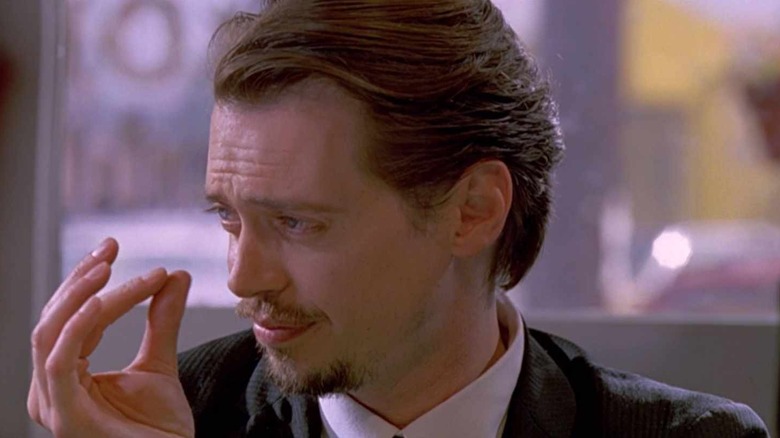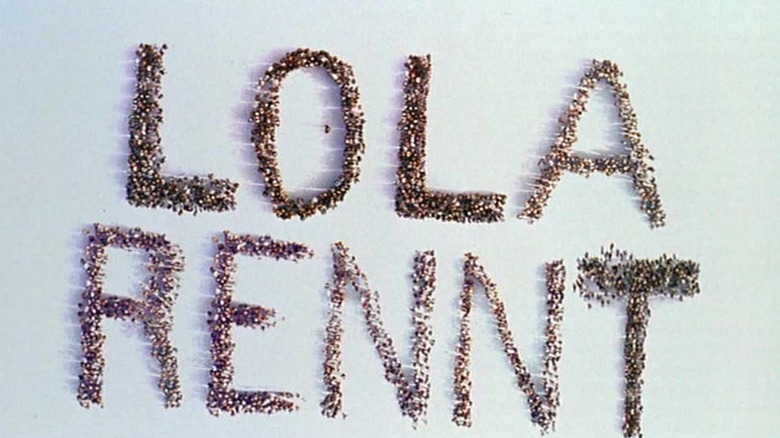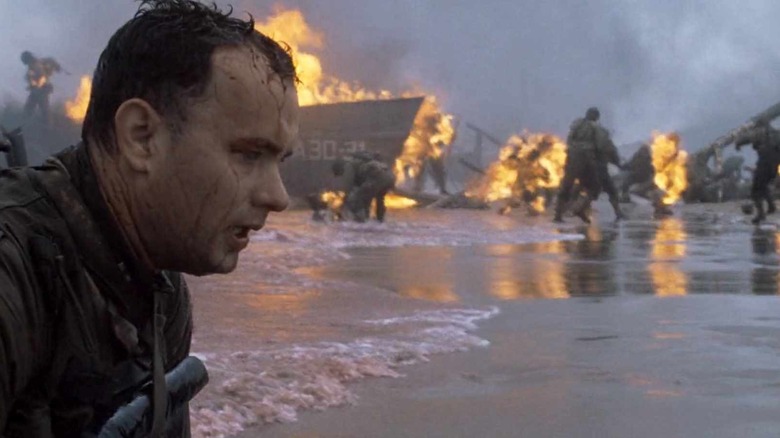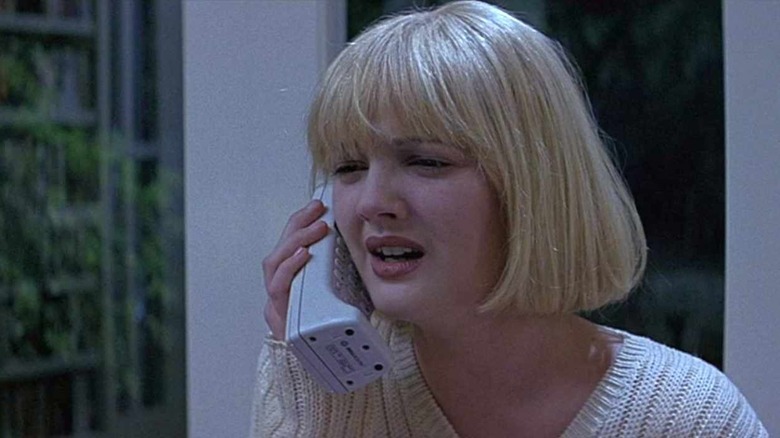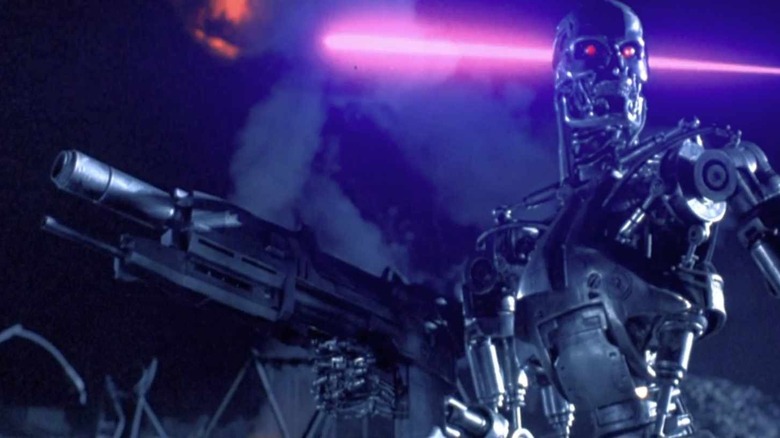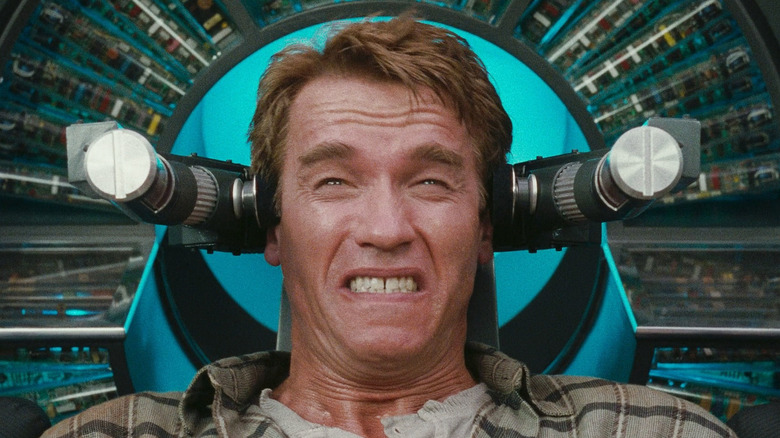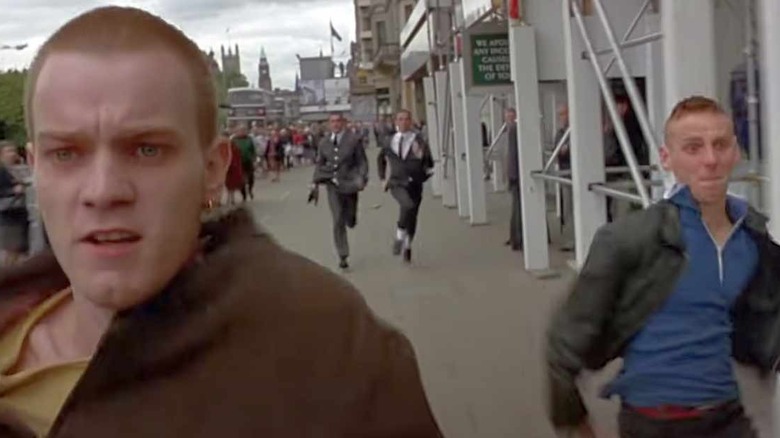The Best Opening Scenes In '90s Movies
Go big or go home is the mantra that all movies should follow when crafting an opening scene. Some get better as they go along, but the best ones open with an exclamation point, grabbing your attention from the get go and locking you in for the rest of the picture.
Some of the strongest, most memorable opening scenes came out of movies released in the 1990s, a time when independent filmmakers brought something new to the table, foreign ones dazzled viewers at breakneck speeds, and modern masters showed they could still deliver the goods.
The indelible opening scenes from the '90s arrived in all shapes and sizes, countries and universes, and times past and present — the birth of a lion cub, witty banter in a diner, grooving at a disco, a bloody day at the beach, a stroll on mars, journeying beyond the stars, warnings of a bad future, and even a lobster dinner with George and Barbara Bush. Here they are, the best of the best from the last decade of the 20th century.
Boogie Nights (1997)
It's a bopping 1977 evening in the San Fernando Valley, as a group of moviegoers leave a theater with "Boogie Nights" in Candice font lit up on its marquee. The smooth sounds of The Emotions' "Best of My Love" swells (director Paul Thomas Anderson told NPR it was the only choice after "Carlito's Way" used "Got To Be Real") as the action, in one long and luscious continuous take, is shifted to a nearby discotheque called Hot Traxx. In a whirlwind spin around the club, a majority of the film's characters, who are involved in the adult film industry, are introduced (and in some cases, the actor is making their first introduction to an audience in a breakout role), enjoying the groovy good life. Famed smut director Jack Horner (Burt Reynolds) is holding court, but his attention is stolen by a young busboy (Mark Wahlberg); he sees something in him — "I got a feeling, behind those jeans, there's something wonderful just waiting to get out."
The scene, which reviewer Joe Baltake called an "electrifying burst of neon-tinted energy," breaks out the funk, before things in the picture eventually become a little too funky (and awfully depressing). Anderson, who creatively borrowed from Scorsese's "Goodfellas," would later say in a 2003 interview at Croatia's Motovun Film Festival that "you don't want to do something just to show off ... but if you can show off and this also kind of helps progress the story ... in a really interesting way you can introduce the characters. Then that's good ... just don't get caught."
Cliffhanger (1993)
4,000 feet up in the sky, stuck on a mountain peak are an injured climber (Michael Rooker) and his fiancée Sarah (Michelle Joyner), but help is on the way in the form of Sylvester Stallone. Director Renny Harlin swoops viewers in on the action, and then heightens the drama during the rescue when nervous novice Sarah has to rope slide from the peak to a helicopter. Her harness strap goes untied, and her clip breaks, leaving her to dangle over a gorge. This real cliffhanger of a scene is punctuated when Stallone hurries to save her, but a slip of a glove has her descending to death (following the stuffed animal who went before her).
This incredibly harrowing opening to 1993's "Cliffhanger" didn't exist as we know it. Director Harlin was skeptical of casting Stallone in the lead after coming off a string of flops, but had a change of heart after a productive lunch between the two. Harlin said he'd scrap his original heroic rescue opening, telling Stallone, "if you're playing the part, I want you to fail, and I want you to kill the girl," and it was re-written as such.
The scene even impressed those who worked on the film, such as editor Frank Urioste, who admitted on the DVD commentary that the rest of the movie paled in comparison to that opening. Michelle Joyner, who played the doomed Sarah, told the VHS Podcast that her stunt work tested her bravery, and also earned her the disdain of co-star Stallone, who was very much afraid of heights.
Contact (1997)
Hovering above Earth, a cacophony of audio transmissions are playing over one another in the opening of "Contact," as the camera pulls away in a backward zoom from the blue planet, then deeper and deeper into the far reaches of space. The Academy Award nominated soundscape starts from the 1997 present (Spice Girls' "Wannabe") and ripples through the past (from Neil Armstrong's "one small step" speech to even Morse code), until silence sets in at the furthest point the planet's audio has traveled. Swirls of beautiful colors and starry shapes rapidly fly by (take that, Stanley Kubrick and your "Space Odyssey"), dazzling the eye as it exits the solar system and onto the endless reaches of the universe, before hyper-speedily clustering together in a white starry mash and then fading away into the eye of the film's protagonist, young Ellie Arroway.
The adult Ellie, who believed that a further truth existed beyond the stars, was played by Jodie Foster, who said on the DVD commentary (via Art of the Title) that this "spectacular" opening sequence "is a view of the universe that no one has ever had and it really comes out of Carl Sagan's life's work."
In their own commentary, director Robert Zemeckis said showing this "universe in the blink of an eye" became a running theme for all that followed in the movie, to which producer Steven Starkey spoke for all the starstrucked viewers when saying with this new distant view, "you render yourself rather insignificant in relation to the whole."
The "Contact" opening scene is still doing as such, inspiring the opening sequence of the "Loki" Season One finale.
Goodfellas (1990)
It's "New York, 1970" and three men are bleary-eyed driving, but jolted to attention by the sound of thumps coming from the trunk. They pull over, and the driver (Ray Liotta) opens the trunk; a bloodied man is revealed as the thumper, then another man (Joe Pesci) whips out a knife and viciously stabs the trunk resident, followed by the third man (Robert DeNiro) pulling out a gun and plugging multiple shots into him. As the camera's focus returns to the driver, closing the trunk, he tells the audience, "as far back as I can remember, I always wanted to be a gangster." It freezes on his face and cuts to black as Tony Bennett's "Rags to Riches" plays and the Saul and Elaine Bass opening credits to 1990's "Goodfellas" roll.
Michael Imperioli, who played Spider, told GQ that while Scorsese is serving up romantic 50s nostalgia in some parts of the movie, "why he opens the movie with this very brutal killing is that he doesn't want us to get lost so much in that innocence." This savage, yet glamorized opening salvo sets the tone for what is to follow, based on the high crimes and times of Henry Hill, and makes more sense in context when this murder scene of Billy Batts (Frank Vincent) is played out later in the film.
Scorsese revealed to EW in 2019 that an early cut contained even more knife cuts in the opening scene, leading to walkouts in test screenings. It prompted him to have his editor Thelma Schoonmaker scale it back, telling her "We didn't need them leaving this soon, okay? We see the knife, we get it."
JFK (1991)
Oliver Stone "hit the central nerve core of the establishment" (via Variety) with critics and historians in 1991's "JFK," a muckraking screen attempt to bring to light the secret, unknown darkness that may (or may not) have orchestrated the assassination of the 35th US president.
After more than 3 hours of presenting "evidence," the Shakespearean phrase "what's past is prologue" appears as the penultimate line of text before the end credits scroll. Fitting, as the prologue at the head of the film gives viewers a well needed overview of the past that leads up to that fateful November day in 1963, the hunt for the truth that followed, and the ripple effect it had on America.
Academy Award winning cinematographer Robert Richardson said that with "JFK," he and Stone "created a strong documentary feel for the first two sections of the film" (via "Virgin Film: Oliver Stone") and nowhere is that better put into play than in that "daringly and dazzlingly" opening montage which combines newsreel footage and new footage stylized to match.
Starting with exiting President Eisenhower's words of warning about the power that revolves around the military industrial complex, followed by the rise of his successor, John Fitzgerald Kennedy, and both the hope and danger he brought to the office, John Williams' noble score is perfectly matched with crisp narration from Martin Sheen (no stranger to Kennedy or presidential screen work) in this summarization of historical events. Stone also takes great care to humanize Kennedy in the montage, showing his glossy-smiling family life, and ending with a quote of his saying "we are all mortal," before he delves into unraveling all the theories behind the conspiracies.
The Lion King (1994)
"The Lion King" was a big departure and gamble for Disney — a cartoon without humans, the first not based on an existing property, and for the first time in five years, one to be released in summer, instead of their usual comfy winter spot. But Disney so believed in the movie, and especially in its opening scene, that when the trailer was released in theaters it was "unlike the usual preview that consists of separate scenes edited together to give away the whole story, 'The Lion King' trailer is simply the first 4 minutes and 18 seconds of the film" (via Pensacola News Journal).
In that 4 minutes and 18 seconds, the sun rises over the Pride Lands of Africa, as all the beautiful animals in the kingdom rise up and gather round to celebrate the monumental birth of the Lion King's son Simba. The only thing missing in the scene is dialogue, which was originally intended to be included, but co-director Roger Allers said "the turning point was when [composer] Hans [Zimmer] did his treatment of [Elton John and Tom Rice's] 'Circle of Life.' We had built the sequence with all the animals going to Pride Rock, music at the front, and then dialogue with Rafiki. Then we went to Hans and he played the song on its own and we were blown away by it."
Audiences were blown away by it too, including President Barack Obama, who later used a portion of the opening scene as his "official birth video," unveiled at the 2011 White House Correspondents Dinner ... among the evening's events that dismayed Donald Trump.
Naked Gun 2 1/2: The Smell of Fear (1991)
After terrorizing Queen Elizabeth the II (but also saving her life) in the conclusion of 1988's utterly punny "Naked Gun: From the Files of Police Squad!," Detective Frank Drebin (Leslie Nielsen) brought his world of slapstick trouble to the White House in the riotous opening of its 1991 sequel – "The Naked Gun 2 1/2: The Smell of Fear."
Celebrating his 1,000th drug dealer killed, Drebin is a guest of President George HW Bush, and the thanks he gives in return is obliviously battering around his wife, First Lady Barbara Bush (lookalikes Ron Long and Margery Rose). Drebin walks around with wide eyes and a big smile, and without the knowledge that he's smacking her nose with a door, banging her head under a table and — in his knockout move — punching her face after having some big trouble with an oversized lobster claw. From there, more hilarity ensues, all the way to the end of the film, where Drebin knocks Mrs. Bush over a railing, leaving her dangling as the end credits roll.
The Bush's children were scared of what their parents would think of the film, but Barbara told them "We saw it and I loved it and Dad loved it." Although she added, "The darn trouble is, she looks exactly like me. She has the pearls. She has the mannerisms. I recognized myself." Leslie Nielsen was worried too, but all was in good humor when he attended a White House function and even posed for a photo with the President and the First Lady.
Pulp Fiction (1994)
"Reservoir Dogs" woke the world up to the wonderful, twisted mind of Quentin Tarantino, and in his follow-up film, 1994's "Pulp Fiction," he went back to the well and started off with some criminals talking casually at a Googie coffee shop (sadly demolished in 1999).
This time around, it's a pair of con lovers with the pet nicknames Pumpkin and Honey Bunny (Tim Roth and Amanda Plummer) who weigh the pros and cons of robberies. Over coffee and cute talk, the star crossed lovers realize that a restaurant actually poses the least risk, and the most amount of wallets, and on a whim decide to knock over the joint right then and there. The man jumps up on the booth's seat, waving a gun and screams "Everybody be cool, this is a robbery!" A freeze on their faces holds, "Miserlou" jumps right in, and so begins one of most beloved films of the 1990s.
Tarantino said that the Dale song "just says you're watching an epic, you're watching this big old movie ...it throws down a gauntlet that the movie now has to live up to, 'cause it's just saying 'we're big.'" The opening scene was so pivotal to the rest of the "big" film that it needed a 2 hour break before circling back and bringing it to a conclusion, with a little help from diner patrons Vincent Vega (John Travolta) and Jules Winnfield (Samuel L. Jackson).
Reservoir Dogs (1992)
The conversational genius of Tarantino was on full display from the first shot of his first feature, and especially in its very first scene, perhaps inspired by Barry Levinson's seminal "Diner."
A group of well-dressed color-named Misters (an amazing ensemble including the likes of Harvey Keitel, Steve Buscemi, Chris Penn, et al) sit around a round table, chatting and chewing, oozing cool quotable dialogue with each passing and cutting sentence that is verbalized. Topics ranged from the true meaning behind Madonna's "Like A Virgin," to remembering a last name in an address book, to the very concept of whether tipping a server is mandatory. Cue the world's smallest violin.
As the "ramblers" are about to "get ramblin", Steven Wright's monotone voice takes us out as DJ K-Billy and his Super Sounds of the '70s, leading into one of the most memorable opening credit sequences of the '90s. Which was borrowed, with love, five years later in another seminal Miramax film: "Swingers."
Tarantino broke down his opening scene with a "cinéma-vérité give and take" to Film Comment in 1994, explaining how each of the three discussions held within it were shot in different styles. He said, "Whenever you do a scene that long, you have it break it down into sections. Ten minutes for your opening sequence is a real long ... time, especially if they're doing nothing but sitting down talking."
Run Lola Run (1998)
A creepy clock's pendulum swings, setting in motion the importance of time in 1998's Tom Tykwer's "film about a person bursting with passionate energy, so it has to be a film that bursts out with passionate energy."
This "passionate energy" continues in the opening scene, as a flurry of people rush by one another, sometimes focusing on supporting characters to be met later on, while a narrator posits that man is filled with "a mystery of unanswered questions," and besides the basic facts of soccer, "everything else is pure theory." A ball is kicked into the air, and 300 extras assemble to form each letter of the film's German title "Lola Rennt" ("Run Lola Run").
In the DVD commentary, Tykwer said "this is the opening of the film as I wanted it always wanted it to become, that it looks in the first place as a horror movie ... but it doesn't really turn out to become a horror movie in the end."
The story that follows focuses on a fiery red-headed girl named Lola (Franka Potente) who is in quite a predicament: her boyfriend Manni (Moritz Bleibtreu) needs 100,000 Deutschmarks in 20 minutes or he will be killed. Told in three hurried acts, all with different fated outcomes, "Run Lola Run" finds our titular heroine running across Berlin to try and save the day, brushing up against the characters introduced in the title spell-out, often altering the fates of all involved in the process.
Saving Private Ryan (1998)
Sometimes the next generation needs a history lesson on the previous one; the greatest generation's WWII sacrifices got a long overdue refresher for all generations going forward from one of modern's cinema's finest filmmakers: Steven Spielberg. In his 1994 five time Academy Award winning "Ryan," Spielberg not only shows the audience the horrors of war, he makes them feel it with the unflinching, audiovisual techniques of a master.
Technically, the first scene of "Ryan" features an elderly man visiting Normandy American Cemetery in France during the present day, trembling in front of the sight of endless rows of his fellow fallen freedom fighters, interred under white crosses; when it cuts from a close up of his tears to the US army landing on Omaha Beach, the film truly begins. What follows is the unbelievable 20-plus minute Normandy Beach invasion that is not only one of the greatest openings of '90s movies, but of all time — a history lesson no one should forget.
The scene alone cost $12 million to produce, and included the talents of 1,500 people, a lot of explosives and endless fake blood, splashed about an Irish beach (via Independent). Spielberg told the DGA in 2011, "I was trying to honor the experience of what these veterans articulated to me. Their descriptions of the bloody beach really stuck in my memory," adding "I chose to acquit those factual experiences with imagery that I never censored or even questioned. My intention was to re-sensitize the audience."
Scream (1996)
When filmmaker Wes Craven teamed up with scribe Kevin Williamson, horror movies would never be the same again.
Much like Hitchcock had done with "Psycho," the film was launched by the killing of what many audience members would assume would be its lead. It was a warning shot for the franchise: nobody is safe.
For a dozen panic-stricken minutes, Drew Barrymore's character is toyed with by a raspy stranger on the phone, who asks her if she "likes scary movies," and in turn she becomes a part of her own scary movie. The caller eventually rears its ugly head, appearing at the girl's isolated house in an Edvard Munch-scream-like mask. The scene introduced the world to the killer Ghostface, and a film franchise that has since gone on to produce four sequels and raked in over $742 million dollars worldwide.
Barrymore was initially eyed for the role of the main heroine Sydney Prescott, but gravitated toward the Casey character.
"The first scene was really reminiscent to me of 'When A Stranger Calls'," she told EW in 2011. "Like these great things that left you wanting more."
Terminator 2: Judgment Day (1991)
It took seven long years before director James Cameron and Arnold Schwarzenegger went back to "The Terminator" for 1991's "Judgment Day." The wait was worthwhile; it is perhaps one of the finest sequels ever made. Everything in the follow-up was bigger and badder, and in an audio commentary, writer William Wisher joked that the opening scene "cost as much as the entire first film."
The scene begins in modern Los Angeles — cars on a highway, followed by children enjoying a playground — before the sunny day is eclipsed by a hellish future darkness, showing it all burned to a crisp, as we learn of a nuclear fire that killed three billions lives in 1997. The ensuing nightmarish war against the machines was dubbed "Judgment Day," and the battle still rages on in 2029, in an unforgettable prelude which includes a first time on-screen appearance by the leader of the resistance: Sarah Connor's son, John.
"I always really loved this sequence — as small as it is in the overall context of the film," Wisher says in the film's audio commentary. "To be able to see John Connor ... was really important, because it makes him real."
An alternate ending to the film, which was never used, would have acted as the perfect bookend to that impressive opening scene. It's a utopian time, with "the dark future that never came," and while Sarah Connor lives with knowledge of the horror of what could have been, she is still able to enjoy a bit of peace watching her son and granddaughter live and be free ... on a playground.
Total Recall (1990)
The tug of war that Paul Verhoeven constantly pulls on his "Total Recall" main character and audience, taking everyone back and forth to second guess if what they're seeing is real or all just a dream, at times seems cruel. But it's all in the spirit of the short story "We Can Remember It for You Wholesale."
"Recall" opens on a believable looking Martian landscape, with a happy couple (Arnold Schwarzenegger and Rachel Ticotin) enjoying the views while walking along its red-grained surface. A slip in the sand sends the man falling down into a canyon, where his helmet breaks open, exposing him to the noxious Martian atmosphere, causing his face and eyes to monstrously bulge, and giving the world one of its greatest Schwarzenegger face looks (with the help of a puppet) in his entire oeuvre.
Schwarzenegger's Quaid wakes up from this nightmare, but it's okay, because, as Schwarzenegger says on the DVD commentary, "this was one of my favorite scenes, obviously, because how many times do people get a chance to wake up with Sharon Stone?" They get awfully playful in bed (which the duo and their director rehearsed before shooting at the Bellagio Hotel), but he gets distracted by news reports from Mars, and that his mission in life is to get there (by implanted memory or by any means necessary). The mission is set, and from here, the movie turns into an adventure of a lifetime — a set of Martian chronicles that would even wow Ray Bradbury.
Trainspotting (1996)
A low angle shot of a busy city sidewalk pops on screen, a pair of thieves hit the ground running, joined by the mashing drumbeat of Iggy Pop's "Lust for Life," as a narrator chimes in with a "choose life" monologue so momentous it warranted its own movie poster, and it's off to the races in Danny Boyle's 1996 big screen adaptation of Irvine Welsh's chic, sick heroin novel "Trainspotting." With this ultra-punchy, frenetic opening, the principal characters are all introduced (in various states of either high-highs or high-lows, plus a lot of talk about Sean Connery's career), and yells as if to say — you ain't seen nothing yet.
Scottish cinema was instantly put on the map, and a welcome party was thrown for a new generation of great actors, including Ewan McGregor, Johnny Lee Miller, Robert Carylyle and Shirley Henderson. Boyle would later joke to Miller that the film was so popular back home that "'Trainspotting' is like Scotland's 'Star Wars.'"
The chase scene in the opener was shot using a quad bike on Princes Street in Edinburgh, Scotland, and had the actors lost for breath (much like the audience watching them). Producer Andrew Macdonald recalled to The Scotsman, "It was complete naivety. People were just jumping or being pushed out of the way. There was no crowd control. Just crazy, we could have killed someone." Director Boyle added, "You'd never get permission to film this way now," but luckily they did, and paid homage to the opening chase in a 2017 sequel.
